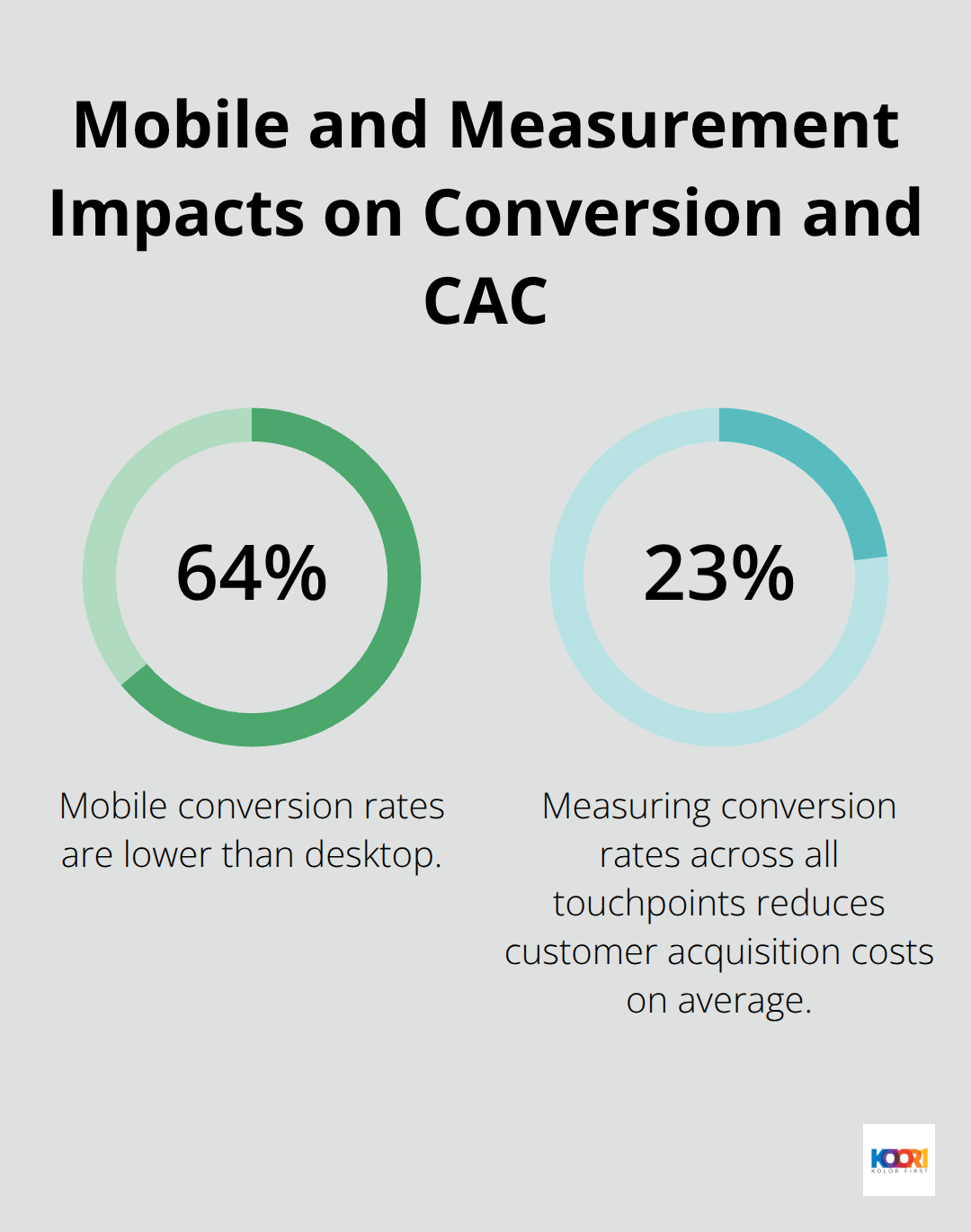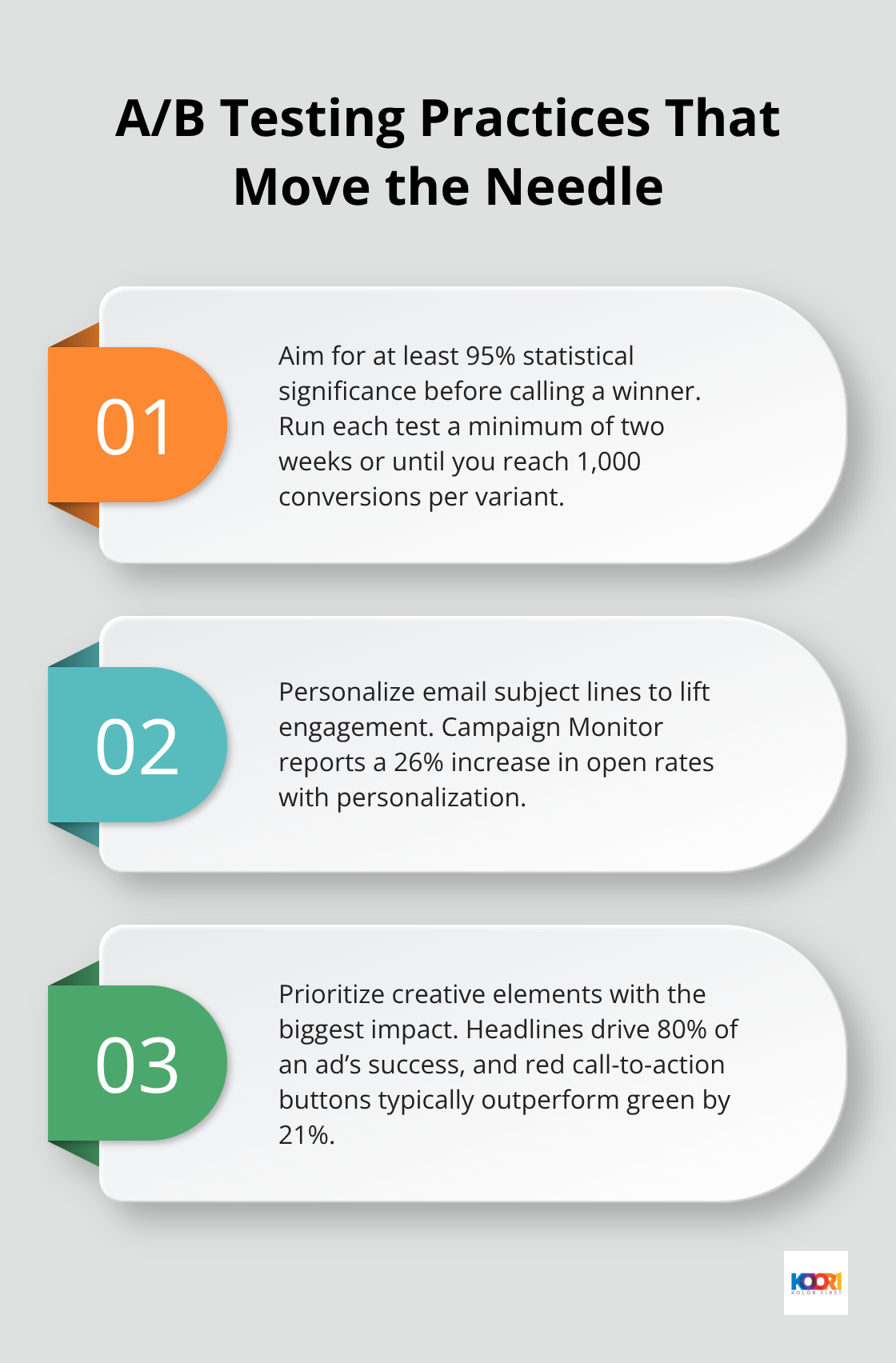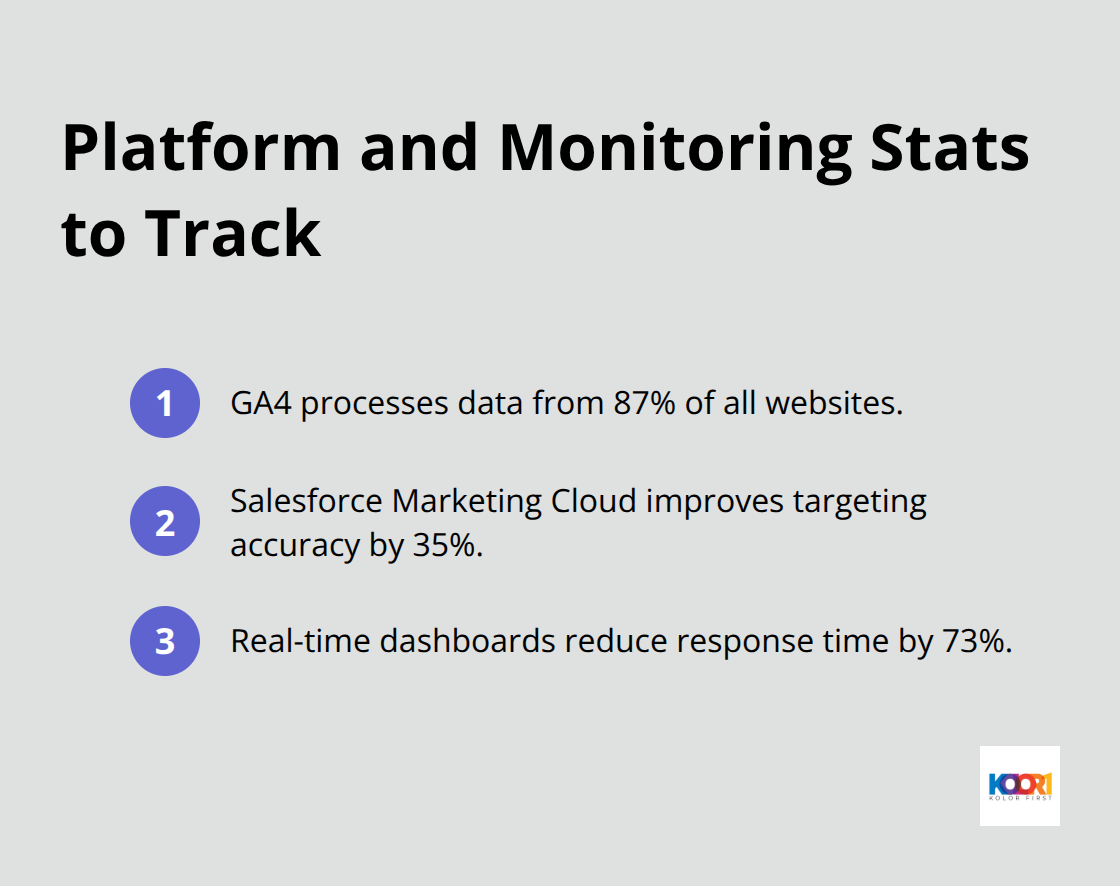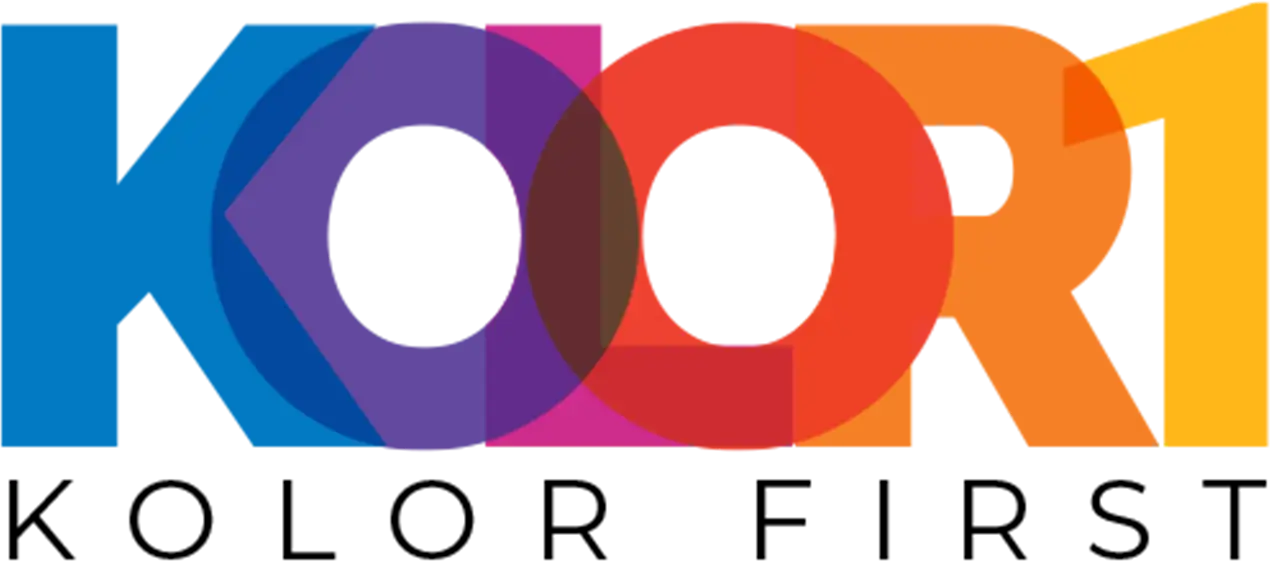Marketing performance optimization separates successful businesses from those struggling to grow. Companies waste billions annually on campaigns that don’t deliver measurable results.
We at Kolorfirst LLC know that data-driven marketing isn’t optional anymore. The right metrics and tools can transform your marketing ROI within months.
Which Metrics Actually Drive Marketing Success
Revenue attribution shows you exactly which campaigns generate real business impact. Track revenue directly to specific touchpoints rather than relying on vanity metrics like impressions or clicks. Modern attribution platforms can increase attributed revenue by 23% compared to last-click models. Customer acquisition cost requires calculation by channel and comparison against customer lifetime value. The best-performing companies maintain a 3:1 CLV to CAC ratio, according to HubSpot’s research. Calculate acquisition costs monthly, not quarterly, to catch underperforming campaigns early.
Conversion Rate Analysis Across Channels
Search ads typically convert at 3-5%, while social media ads average 0.9-1.5%. Email marketing outperforms both with conversion rates that reach 15-20% for segmented campaigns. Monitor conversion rates by traffic source, device type, and audience segment. Google Analytics reveals that mobile conversion rates are 64% lower than desktop, which makes mobile optimization essential. Track micro-conversions like email signups and content downloads to understand the full customer journey. Companies that measure conversion rates across all touchpoints reduce their customer acquisition costs by an average of 23%.

Customer Lifetime Value Optimization
Calculate CLV with purchase frequency, average order value, and customer lifespan (three key components that determine long-term profitability). E-commerce businesses with CLV tracking increase revenue by 25% within six months. Segment customers by value tiers and create targeted retention campaigns for high-value segments. The top 20% of customers typically generate 80% of revenue. Focus marketing spend on customers who match your highest-value segments. Use cohort analysis to track how customer value changes over time and identify retention opportunities.
Attribution Model Selection
First-touch attribution credits the initial interaction, while last-touch gives all credit to the final touchpoint before conversion. Multi-touch models distribute credit across all interactions (providing a more complete picture of the customer journey). Linear attribution assigns equal weight to each touchpoint, while time-decay models give more credit to recent interactions. Companies using multi-touch attribution see better campaign performance than single-touch models. Choose attribution models based on your sales cycle length and customer behavior patterns.
These metrics form the foundation for data-driven optimization strategies that transform campaign performance through systematic testing and refinement.
How Do You Test Your Way to Better Marketing Results
Testing campaign elements systematically separates high-performing marketers from those who guess their way through optimization. Split test one element at a time to isolate what drives conversions. Companies running A/B tests on their campaigns see improved conversion performance compared to those relying on intuition.
Test headlines, call-to-action buttons, landing page layouts, and email subject lines with statistical significance of at least 95%. Run tests for minimum two weeks or until you reach 1,000 conversions per variant. Email subject lines with personalization increase open rates by 26% according to Campaign Monitor data.

Creative Element Testing
Focus your tests on high-impact elements that directly influence conversion decisions. Headlines account for 80% of your ad’s success, making them the priority for split testing. Test emotional triggers against rational benefits to identify what resonates with your audience.
Call-to-action buttons perform differently based on color, text, and placement. Red buttons typically outperform green ones by 21% in most industries. Test button text variations like “Get Started” versus “Try Free” to find language that converts best for your specific audience.
Customer Segmentation Strategies
Customer segmentation based on behavior data outperforms demographic targeting by 40% in conversion rates. Use purchase history, website engagement, and email interaction patterns to create segments. RFM analysis segments customers by recency, frequency, and monetary value of purchases.
High-value segments typically represent 15-20% of your customer base but generate 60-80% of revenue. Create separate campaigns for new customers, repeat buyers, and dormant users with tailored messaging for each group. Behavioral triggers like cart abandonment or product browsing patterns provide more actionable insights than age or location data.
Attribution Model Selection
Multi-touch attribution models provide 30% more accurate ROI measurements than last-click attribution for businesses with sales cycles longer than 30 days. Time-decay attribution works best for B2B companies where customers research extensively before purchasing.
Position-based attribution gives 40% credit to first and last touchpoints (distributing remaining 20% across middle interactions). Salesforce research shows that companies using data-driven attribution see 15-20% improvement in marketing efficiency. Match your attribution model to customer behavior patterns rather than defaulting to platform recommendations.
The right tools and technologies make these optimization strategies scalable and actionable across your entire digital marketing operation.
Which Tools Actually Track Marketing Performance
Google Analytics 4 processes data from 87% of all websites and provides attribution models that track customer journeys across devices. HubSpot CRM integrates with major advertising platforms and shows which campaigns generate the highest lifetime value customers. Salesforce Marketing Cloud connects email, social, and advertising data into unified customer profiles that improve targeting accuracy by 35%. Adobe Analytics delivers real-time segmentation capabilities that help identify high-converting audience segments within hours rather than days. These platforms eliminate data silos that prevent accurate performance measurement across channels.
Marketing Analytics Platform Selection
Tableau connects to over 70 data sources and creates automated dashboards that update every 15 minutes with campaign performance metrics. Microsoft Power BI costs 60% less than competing solutions while it provides the same visualization capabilities for marketing teams with limited budgets. Looker Studio integrates directly with Google Ads and Facebook Ads to show cost-per-acquisition changes in real-time. Companies that use comprehensive analytics platforms see 23% better campaign performance than those relying on single-platform reporting.
Real-Time Performance Monitoring
Automated alerts notify marketers when conversion rates drop below predefined thresholds and enable immediate campaign adjustments. Companies that use real-time dashboards reduce their response time to performance issues by 73% according to Gartner research. Real-time monitoring prevents budget waste on underperforming campaigns (saving an average of 18% in monthly ad spend).

Performance tracking systems that update hourly catch optimization opportunities that daily reports miss entirely.
CRM Integration Benefits
Integrated CRM systems track revenue attribution from first touchpoint to final purchase and provide complete customer journey visibility. Pipedrive shows that marketing-qualified leads convert 47% faster when sales and marketing data synchronize properly. ActiveCampaign combines email marketing with CRM functionality and allows marketers to trigger campaigns based on sales pipeline stages. Automated lead scoring assigns points based on website behavior and email engagement while it helps sales teams prioritize follow-up activities.
Marketing Automation Workflows
Marketing automation workflows that connect to CRM data drive a 14.5% increase in sales productivity and a 12.2% reduction in marketing overhead overall. Automated nurture sequences trigger based on customer behavior patterns and deliver personalized content at optimal times. Workflow automation reduces manual campaign management by 67% while it maintains consistent customer communication across all touchpoints. Advanced automation platforms score leads automatically and route high-value prospects to sales teams within minutes of conversion.
Final Thoughts
Marketing performance optimization demands systematic measurement, continuous tests, and the right technology stack. Companies that track revenue attribution, customer lifetime value, and conversion rates across channels see measurable improvements within months. A/B tests of campaign elements while customer segments based on behavior data drive better results than demographic targets alone.
Implementation starts with analytics platforms that integrate with your CRM system. Set up automated dashboards that monitor key metrics in real-time and trigger alerts when performance drops. Focus test efforts on high-impact elements like headlines and call-to-action buttons that directly influence conversion decisions.
Data-driven marketing delivers compound benefits over time. Organizations that use multi-touch attribution models and automated workflows reduce customer acquisition costs by 23% while they increase sales productivity by 14.5% (according to Salesforce research). We at Kolorfirst LLC help businesses optimize marketing performance through proven strategies that transform marketing from cost center to profit driver.






